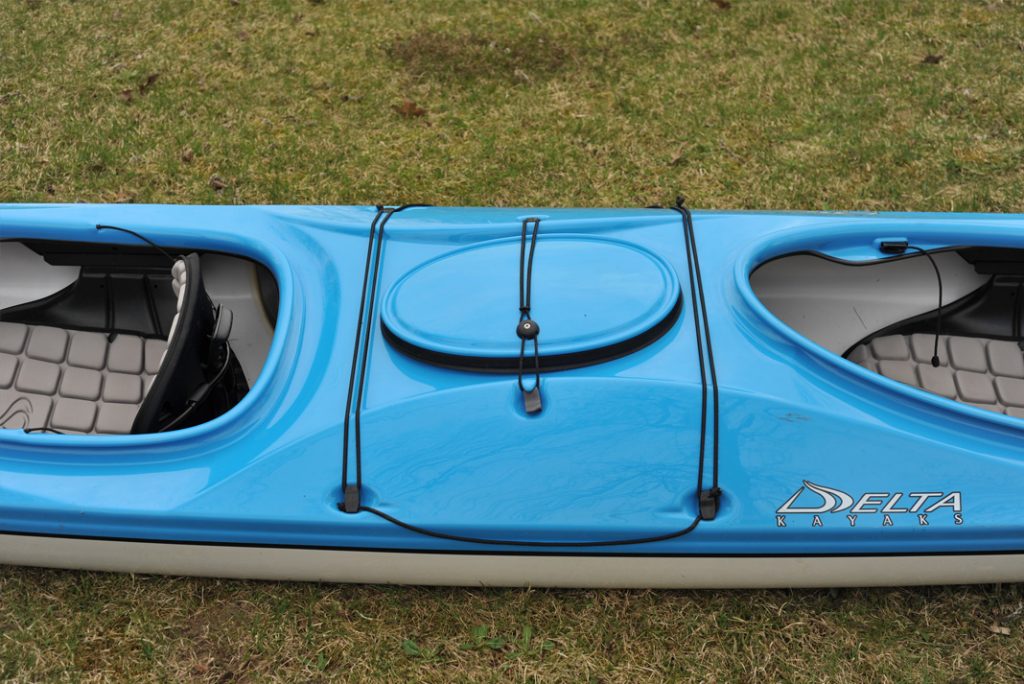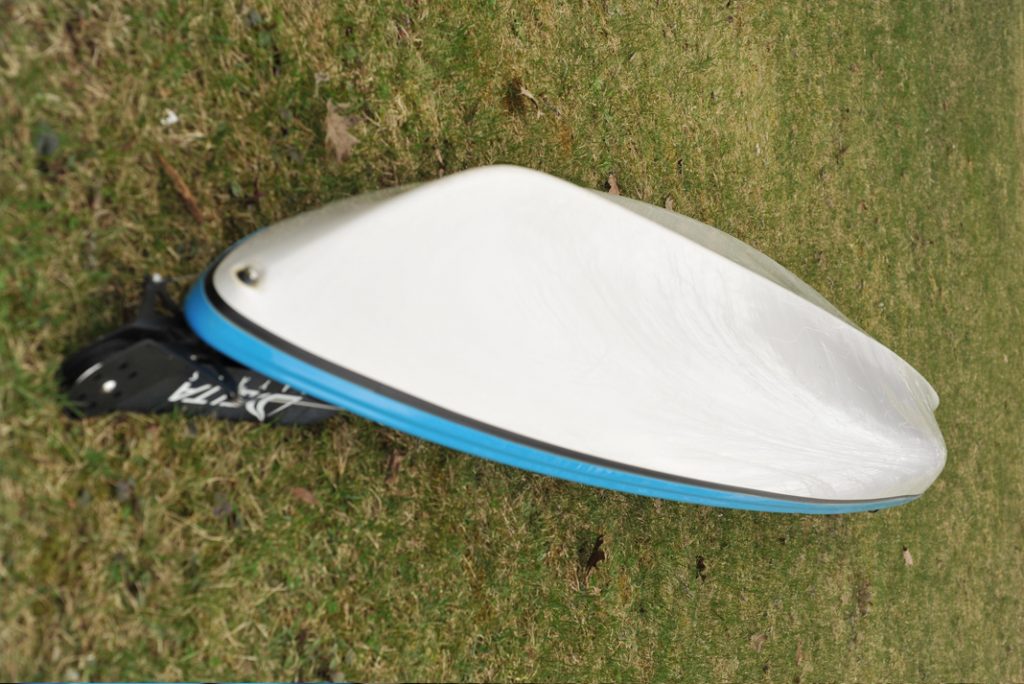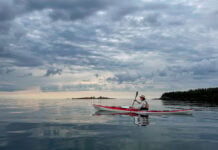I’m a big fan of tandem kayaks. A fleet of doubles halves the number of boats on the water, making it easier to keep the group together, and they provide opportunities to pair stronger paddlers with those who are fatigued, seasick or otherwise struggling. Even a single tandem can be a huge asset to a group—think of it like an insurance policy. Enter the Delta Traverse 17.5 T, a new compact tandem embodying the new light touring ethos in a double design.
Delta Traverse 17.5 T Specs
Length: 17’ 6”
Width: 27.25”
Weight: 70 lbs
Max Capacity: 560 lbs
MSRP: $2,750 USD
Despite their many benefits, some paddlers still have reservations regarding doubles. For starters, there’s the stigma of the “divorce boat.” It’s true, paddling tandem does take more coordination and communication than piloting solo, but I’ve seen a great many more pairs flourish rather than flounder.
The Traverse 17.5 T puts the focus on convenience
At a time when most paddling trips are just a couple of hours to a couple of days long and kayak sales are dominated by shorter, lighter boats, the biggest hurdle for tandems may be, well, their size.
Many traditional tandems were designed for—and excel at—expedition-style journeying. But casual paddling partners out for an afternoon or weekend don’t need cargo ship capacity. Add waterlines that project nine feet beyond the bars of a hatchback’s roof rack and 80 to 105-pound hull weights, and the honeymoon is over before it’s even hit the water.
The Delta Kayaks’ Traverse 17.5T is not merely a downsized version of Delta’s other tandem offering, the 20 T; it’s a fresh take informed by the brand’s spectrum of popular single kayaks.

We pick up our demo 17.5 T at White Squall, a Parry Sound, Ontario, paddling center whose racks are piled high with spring inventory of Delta kayaks. For budget-conscious paddlers seeking a boat that’s capable, attractive, user-friendly and lightweight, Delta’s thermoform plastic offerings tick all the right boxes. The finish of their durable vacuum-molded, ABS-acrylic laminate kayaks is flawless—and our Traverse is no exception.
A weight off your shoulders
The first thing anyone who has ever paddled tandem will notice about this double is the weight—or lack thereof. Historically, wrangling a touring tandem onto and off of your vehicle’s roof was a feat requiring near-Herculean strength—and ideally a footstool. The Traverse tips the scales at a modest 70 pounds; that’s just a chubby housecat more than my 16-foot single.
Delta’s designers finessed two cockpits into the Traverse’s 17-and-a-half feet—a length more typical of solo sea kayaks than tandems. As veterans of tandem bicycles and boats know (and the uninitiated soon discover), cockpit proximity is one of the finer points of double design. Too close together and unsynchronized paddle strokes amount to a jousting match. The 17.5 T, we are relieved to report, gets paddler positioning just right.

A comfortable fit for two
In-cockpit adjustments are a breeze thanks to Delta’s straightforward outfitting. The foot braces and multi-height backrest are accessible while seated, and fine-tuning backrest tilt and fore-aft positioning of the sliding seats can be accomplished with one hand. The latter is especially helpful for paddling partners of different heights and weights. For example, rather than adding ballast in the bow hatch to offset a heavier stern paddler, the bow paddler can simply slide his or her seat forward to trim the boat.
While the beamier dimensions of some tandems can hinder their fit for smaller paddlers, this is not the case with the 17.5 T. The thigh braces and other contact points feel secure at both bow and stern cockpits. Stylishly sculpted deck cutaways at both paddler stations reduce interference and enhance stroke efficiency. In fact, working from either seat feels uncannily like paddling Delta’s single kayaks.
Delta is known for accessible designs, and the Traverse is perfectly suited for introducing a friend, partner or family member to kayaking. The boxy hull profile offers outstanding primary stability—it took a considerable, coordinated effort for our test paddlers to achieve a capsize on calm waters. A full-length keel ensures hassle-free tracking; drop the rudder to improve maneuverability in tight quarters. Hull speed is another advantage: two paddlers working together are faster than two single paddlers putting in the same effort.

Ready to try kayak camping? The spacious bow and stern hatches still have ample combined capacity for a pair of weekend adventurers. The center hatch accesses an oversized deck pod with 14 liters of dry storage—handy for snacks, camera, repair kit, spare layers, paddle jackets, and more. Even better, it’s within reach of both paddlers, functionally serving as a shared day hatch, and doesn’t impede foot room for the stern paddler.
Double your fun in the Traverse 17.5 T
Since the earliest kayaks appeared on Arctic waters, tandems—and even triples—have been indispensable—from family freighters to hunting vessels for highly skilled teams. Fast-forward to today’s recreational paddlers and a double still makes a lot of sense. Delta’s Traverse 17.5 T gets two people on the water with less storage and transportation hassles—not to mention less cost—than two comparable singles. Still skeptical? Just grab a friend and take the Traverse for a spin.
This article was first published in Issue 58 of Paddling Magazine. Subscribe to Paddling Magazine’s print and digital editions, or browse the archives.
Double your fun with Delta’s Traverse 17.5 T. | Feature Photo: Owen Marshall









It is nice to see an enthusiastic plug for a double. The reviewer does a good,’hard sell’ for doubles in general and the versatility of this smaller model in particular. My first kayak was a double I built in 1968 a little shorter than the Traverse. I still have it and it gets used occasionally and has been very useful for all the reasons mentioned.
Safety performance was an issue not explored in the review which is a pity because there is a perception, well deserved, that doubles can be difficult to recover if a mishap strikes (1). With better buoyancy design this need not be true but sadly the Traverse 17.5T conforms to the generally poor buoyancy design in the vast majority of commercial kayaks (2, 3). The volume figures for the Traverse total 190 litres of sealed space buoyancy and 367.2 litres of non-buoyant cockpit giving a buoyant to non-buoyant ratio of 0.52. While this is on a par with many single kayaks it could be better and is below average for eight double kayaks from 2007 data (Mean 0.6, N=8). It is a pity reviews such as these do not carry out a Capsize Intake Test (CIT) measurement (4). The air space compartment amidships in the Traverse will undoubtedly help to reduce onboard water after a capsize (= a lower CIT volume) but the aim should be to end up with a CIT measurement of less than 10 litres per seating position. From the Delta website illustrations and the stated cockpit volumes of 170.34 litres fore and 196.84 litres aft there would appear to be ample scope to fit more buoyancy. However, there is no obligation (regulation) requiring manufacturers to do this. Reviewers could provide encouragement in that direction.
References
(1) Broze, M. and Gronseth, G (1997) Sea Kayaker’s Deep Trouble: True Stories and Their Lessons from Sea Kayaker Magazine
ed. Christopher Cunningham International Marine/Ragged Mountain Press
(2) Lamont, P. (2012) Attitudes to buoyancy: a comment on complacency
http://www.windslicer.co.uk/Attitudes_to_buoyancy.pdf
(3) Lamont, P. (2007), Commercially manufactured volumes
http://www.windslicer.co.uk/safety.html/Table1_kayak_volumes.pdf
(4) Carter, P.J. and Lamont, P. (2004) Cockpit intake test: CIT volume
http://www.users.on.net/~pcarter/cit.html